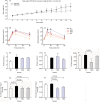Insulin therapy stimulates lipid synthesis and improves endocrine functions of adipocytes in dietary obese C57BL/6 mice
- PMID: 20173758
- PMCID: PMC4002414
- DOI: 10.1038/aps.2010.17
Insulin therapy stimulates lipid synthesis and improves endocrine functions of adipocytes in dietary obese C57BL/6 mice
Abstract
Aim: To evaluate whether insulin intervention could affect the metabolic and endocrine functions of adipose tissue.
Methods: C57BL/6 mice were fed on a high-fat-diet for 12-16 weeks to induce insulin resistance. Insulin intervention was administered in the high-fat-diet mice for 4 weeks at 12 weeks (early insulin treatment) or 16 weeks (late insulin treatment). Intraperitoneal glucose tolerance tests were performed before and after insulin treatment. Expression levels of factors involved in the triglyceride synthesis and endocrine functions of adipose tissue including phosphoenolpyruvate carboxykinase (PEPCK-C), fatty acid synthase (FAS), aquaporin 7 (AQP7), adiponectin, visfatin, and interleukin-6 (IL-6) were determined by Western blot.
Results: In the obese mice, glucose tolerance was impaired; triglyceride content was increased in the liver tissue; protein expression of FAS and adiponectin was decreased; expression of visfatin was increased in adipose tissue. After 4-week insulin treatment, glucose tolerance was improved; triglyceride content was decreased in the liver and skeletal muscle; expression of PEPCK-C, FAS, and adiponectin was increased in the adipose tissue; IL-6 and AQP7 expression was reduced in the fat. Early insulin treatment had better effect in increasing the expression of FAS and PEPCK-C and decreasing the expression of IL-6.
Conclusion: These results indicate that insulin can target adipocytes for improvement of insulin sensitivity through stimulating triglyceride synthesis and partly improving endocrine functions.
Figures



Similar articles
-
Dietary capsaicin reduces obesity-induced insulin resistance and hepatic steatosis in obese mice fed a high-fat diet.Obesity (Silver Spring). 2010 Apr;18(4):780-7. doi: 10.1038/oby.2009.301. Epub 2009 Oct 1. Obesity (Silver Spring). 2010. PMID: 19798065
-
Fenofibrate reverses changes induced by high-fat diet on metabolism in mice muscle and visceral adipocytes.J Cell Physiol. 2018 Apr;233(4):3515-3528. doi: 10.1002/jcp.26203. Epub 2017 Nov 1. J Cell Physiol. 2018. PMID: 28926107
-
Effect of pioglitazone on visfatin expression in 3T3-L1 adipocytes and SD rats.Endocr Res. 2009;34(4):130-41. doi: 10.3109/07435800903287061. Endocr Res. 2009. PMID: 19878073
-
Topical application of capsaicin reduces visceral adipose fat by affecting adipokine levels in high-fat diet-induced obese mice.Obesity (Silver Spring). 2013 Jan;21(1):115-22. doi: 10.1002/oby.20246. Obesity (Silver Spring). 2013. PMID: 23505175
-
The Role of Adipose Tissue and Nutrition in the Regulation of Adiponectin.Nutrients. 2024 Jul 26;16(15):2436. doi: 10.3390/nu16152436. Nutrients. 2024. PMID: 39125318 Free PMC article. Review.
Cited by
-
Altered estrogen receptor expression in skeletal muscle and adipose tissue of female rats fed a high-fat diet.J Appl Physiol (1985). 2011 Apr;110(4):1046-53. doi: 10.1152/japplphysiol.00541.2010. Epub 2011 Jan 13. J Appl Physiol (1985). 2011. PMID: 21233345 Free PMC article.
-
Noninferiority effects on glycemic control and β-cell function improvement in newly diagnosed type 2 diabetes patients: basal insulin monotherapy versus continuous subcutaneous insulin infusion treatment.Diabetes Technol Ther. 2012 Jan;14(1):35-42. doi: 10.1089/dia.2011.0123. Epub 2011 Aug 30. Diabetes Technol Ther. 2012. PMID: 21877913 Free PMC article. Clinical Trial.
-
Recipient Glycemic Micro-environments Govern Therapeutic Effects of Mesenchymal Stem Cell Infusion on Osteopenia.Theranostics. 2017 Mar 6;7(5):1225-1244. doi: 10.7150/thno.18181. eCollection 2017. Theranostics. 2017. PMID: 28435461 Free PMC article.
-
Decreased expression of adipose CD36 and FATP1 are associated with increased plasma non-esterified fatty acids during prolonged fasting in northern elephant seal pups (Mirounga angustirostris).J Exp Biol. 2012 Jul 15;215(Pt 14):2455-64. doi: 10.1242/jeb.069070. J Exp Biol. 2012. PMID: 22723485 Free PMC article.
-
Effects of High-Fat Feeding on Skeletal Muscle Gene Expression in Diabetic Goto-Kakizaki Rats.Gene Regul Syst Bio. 2017 May 29;11:1177625017710009. doi: 10.1177/1177625017710009. eCollection 2017. Gene Regul Syst Bio. 2017. PMID: 28607540 Free PMC article.
References
-
- Weng J, Li Y, Xu W, Shi L, Zhang Q, Zhu D, et al. Effect of intensive insulin therapy on beta-cell function and glycaemic control in patients with newly diagnosed type 2 diabetes: a multicentre randomised parallel-group trial. Lancet. 2008;371:1753–60. - PubMed
-
- Li Y, Xu W, Liao Z, Yao B, Chen X, Huang Z, et al. Induction of long-term glycemic control in newly diagnosed type 2 diabetic patients is associated with improvement of beta-cell function. Diabetes Care. 2004;27:2597–602. - PubMed
-
- Ryan EA, Imes S, Wallace C. Short-term intensive insulin therapy in newly diagnosed type 2 diabetes. Diabetes Care. 2004;27:1028–32. - PubMed
-
- Matthaei S, Stumvoll M, Kellerer M, Haring HU. Pathophysiology and pharmacological treatment of insulin resistance. Endocr Rev. 2000;21:585–618. - PubMed
-
- Tordjman J, Chauvet G, Quette J, Beale EG, Forest C, Antoine B. Thiazolidinediones block fatty acid release by inducing glycero-neogenesis in fat cells. J Biol Chem. 2003;278:18785–90. - PubMed
Publication types
MeSH terms
Substances
LinkOut - more resources
Full Text Sources
Other Literature Sources
Medical
Research Materials
Miscellaneous

